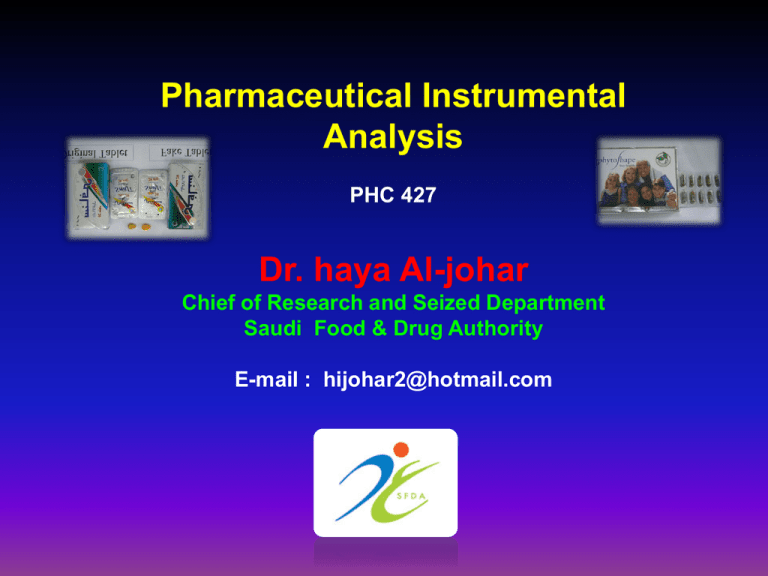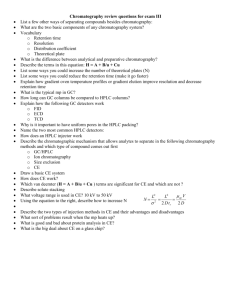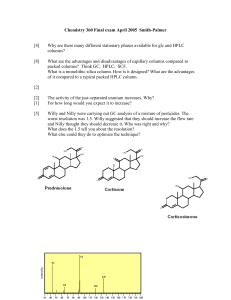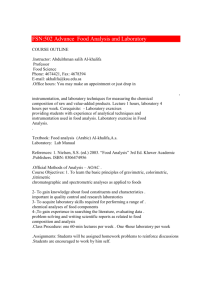HPLC-Dr.haya j
advertisement

Pharmaceutical Instrumental Analysis PHC 427 Dr. haya Al-johar Chief of Research and Seized Department Saudi Food & Drug Authority E-mail : hijohar2@hotmail.com LECTURES’ OUTLINE High performance liquid chromatography (HPLC) Analytical features of HPLC External and internal standard methods Stability-indicating methods of assay. Chiral separation of pharmaceutical compounds Chiral separation of pharmaceutical compound Separation and quantification of related Substances Gas Chromatographic The thermodynamic of gas chromatography. Instrumentation of gas chromatography. Application of gas chromatography. Capillary electrophoresis Principles and instrumentation Choice of optimum conditions for resolution. Modes of electrophoretic separation Applications of capillary electrophoresis Atomic absorption and emission spectrophotometry Instrumentation of atomic absorption Quantitative analysis by of atomic absorption Principles of atomic emission Instrumentation of atomic emission. Applications of atomic emission High Performance Liquid Chromatography (HPLC) Identification: It is apart of chromatography techniques (physical separation) which is a general term applied to a wide variety of separation methods. based on the sample partitioning between a moving (mobile) phase, which can be a gas, liquid, or supercritical fluid, and a stationary phase, which may be either a liquid or a solid. History: The discovery of chromatography is generally credited to Tswett, who in 1906 described his work on using a chalk column to separate pigments in green leaves. 1940 paper chromatography . 1950 gas and thin-layer chromatography. 1960 various gel or size-exclusion methods Classification of chromatographic methods Gas Adsorption Chromatography Competition between a solid adsorbent and the mobile phase St. solid mo. liquid column Liquid Planer layer Partition Chromatography Competition between a liquid stationary phase and the mobile phase St. liquid Mo. liquid Ion Exchange Chromatography Competition between an ion exchange resin stationary phase and liquid mobile phase Permeation Chromatography Competition between a polymer matrix and liquid mobile phase column Gas Solid Chrom. (SSC or GC) Liquid Column Chrom. (LC) High Performance Liquid Chromatography (HPLC) Thin Layer Chrom. (TLC) Paper Chrom. (PC) Gas column Gas Solid Chrom. (GLC) Liquid column Liquid Column Chrom. (LC) High Performance Liquid Chrmatography (HPLC) column Liquid Liquid column Ion Exchange Chrom. (IEC) Gel Permeation Chrom. (GPC) applications of hplc: high-performance liquid chromatography (HPLC) is an analytical technique that is widely used for: separation, Identification (Qualitative analysis) Determination (Quantitative analysis) of the chemical component in a mixture and Preparation of interest components. It is the major and integral analytical tool applied in all stages of drug discovery, development, and production of (API). HPLC is required when: •a mixture is too complex for direct analytical method e.g. spectroscopy. •the materials to be analyzed are very similar e.g. isomer. •it is necessary to prepare highly purified material. •a measurement of the amount of a particular material is needed. In chromatographic process, there are 3 steps: •Injection. •Separation. •Elution. Injection Separation Elution Separation Mechanism Mobile phase (solvent) ↓ ↓ ↓ ↓ A B B C C A Column time Packing material C>B>A Separation is determined by column (packing material) and mobile phase (solvent) The migration of the sample component through the stationary phase is a result of two forces: movement driven by the mobile phase. retardation resulting from the stationary phase. Thus, the sample molecules are held by the stationary phase and transported by the mobile phase. Results obtained by HPLC C A B Chromatogram containing three peaks Qualitative analysis (identification) and Quantitative analysis (determination) Can be performed using the information contained in the chromatogram Identification C What is component A? A B Sample Caffeine Component (A ) elutes the same time as a caffeine peak. Component (A) is identified as caffeine. Determination What is the concentration of component A? C A B Caffeine (1mg/ml) 5ul injection (5ug) Peak area (or height) is proportional to the concentration (or amount) of the component. The concentration of component A (caffeine) is determined by comparing the peak area with that of the standard caffeine peak. HPLC Instrumentation Data processor Column oven Pump Pump Mobile phase reservoir Injector Auto sampler Column Detector Reagent pump Fraction collector waste HPLC Apparatus Mobile phase reservoirs A modern HPLC apparatus is equipped with one or more glass reservoirs each of which contain 500 ml or more of the mobile phase. Often the reservoirs contain a filtration system for filtering dust and particulate matters from the solvent to prevent these particles from damaging the pumps or injection valves or blocking the column. HPLC Apparatus The mobile phase usually produce bubbles in the column and thereby can cause “band spreading” and interfere with the performance of the detector. Therefore, the solvent used must be “degassed” to overcome the dissolved gases. Degassers may consist of a vacuum system, ultrasonic vibration, a system of heating and stirring with reflux condenser, helium or system of sparging. An elution of single solvent system (e.g. 50% water + 50 methanol) of constant composition is termed “isocratic”. In “gradient elution” two or more solvent system that differ in polarity are employed, e.g. methanl (10%, 20% and 30%), and water (90%, 80% and 70%). o Isocratic versus Gradient Elution Isocratic elution has a constant mobile phase composition Gradient elution has a varying mobile phase composition HPLC Apparatus Pumping System The function of the pump in HPLC is to pass the mobile phase through the stationary phase at high pressure and at a controlled flow rate. A pump capable of pumping solvent up to 4000 psi and at flows of up to 10 ml/min the Action of the Pump is most critical, since it must not mixed up the sample being analyzed with the solvent causing loss of resolution. The pump must be made of material, such as stainless steel or teflon; that resist the chemical reaction with the mobile phase. HPLC Apparatus Injector System The Function of the injector is place the sample into the high pressure flow as narrow volume so the sample inters the column as homogenous. There are two main types of injectors: 1) Fixed loop injector. 2) Variable volume injector. The fixed loop has the advantage of high precision of injector volume. But the loop must be overfilled by several times its volume, that is, a 10 l loop requires 30 – 50 l to ensure that it is filled completely with the sample. HPLC Apparatus The variable volume injector, as its name implies, can accommodate volumes from 1 l to 2ml. this has an advantage in that for limited sample sizes and for large preparative work, the same injector may be used without mechanical changing of the loops. Columns Liquid chromatographic columns are constructed from smooth-bore stainless tubing or heavy walled glass tubing. the majority of columns range in length from 10 cm—30 cm, the inside diameter is often from 4 mm to 10 mm ; the common particle size of packing are 3, 5, and 10 m the common column in use is one that is 25 cm in length, 4.6 mm in inside diameter and packed with 5 m particles. HPLC Apparatus Detectors The characteristics of an ideal detector for HPLC include the followings: a) should have a high sensitivity. b) should respond universally with all solutes. c) should have a linear response over several order of concentrations. d) should be insensitive to temp changes & the mobile phase velocity change. e) should be reliable and convenient to use. Unfortunately, no single detector satisfies all these criteria. HPLC Apparatus The detector used in HPLC depends on the nature of the sample. The most widely used detectors in HPLC are: UV detector HPLC Apparatus Diode Array Detector (DAD) HPLC Apparatus Evaporative Light Scattering Detector (ELSD) HPLC Apparatus Electrochemical detector HPLC Apparatus Refractive Index detector HPLC Apparatus Flourescence detector HPLC Apparatus HPLC recorder A data capture system, which may be a computing integrator or a PC with software suitable for processing chromatographic data modes in HPLC LC mode Normal phase Reversed phase Packing materials Silica gel a Silica-C18(ODS) Mobile phase n-Hexane/IPE Adsorption MeOH/Water Hydrophobic Size exclusion Porous polymer THF Ion exchange Ion exchange gel Buffer sol. Packings with ligand Buffer sol. Affinity Interaction Gelpermeation Ion exchange Affinity HPLC Modes 1- Partition Chromatography (PC) the stationary phase is a liquid coated or linked to a solid support retention is due to the partitioning of the solute between the two liquid phases (relative solubility) separation is based mainly on differences between the solubilities of the components in the mobile and stationary phases (liquid liquid chromatography) Cm Cs HPLC Modes Two types of partition chromatography are encountered, namely, normal phase partition chromatography (NPPC) and reversed phase partitioning chromatography (RPPC). In normal phase the stationary phase is normal “polar” (such as triethylglycol or water) & the mobile phase is non polar (such as hexan or diethylether). HPLC Modes In reversed phase chromatography, the stationary phase is non polar (such as C18 phase, C8 phase) and the mobile phase is relatively polar (such as water, methanol) Reversed methods are the most commonly used to prepare bonded phase from silica involves the reaction of the silica with a substituent such as dimethyl chloro silane. HPLC Modes R group may be hydrocarbon such as C18 or C8 or a hydrocarbon with a polar group such as CN or NH2. e.g. to prepare C18 phase. In normal phase chromatography, the least polar elute first. In contrast in the reversed phase the most polar component elute first. “Like Attracts Like, and Opposites are Not Attracted” “Like Attracts Like, and Opposites are Not Attracted” Reversed-Phase Highly polar CH3 CH3 Highly polar CH3 CH3 CH3 CH3 CH3 CH3 Moderately polar Non polar Polar mobile phase Moderately polar No-Polar stationary phase Non polar Non-polar mobile phase Normal-Phase HPLC Modes 2.Adsorption Chromatography (AC) In adsorption chromatography, the analyte species are adsorbed on either the surface of polar solid stationary phase such as silica, alumina, porous glass, when the mobile phase is relatively non polar such as hexane(NPAC) or the surface of non polar solid stationary phase such as polymer beads when the mobile phase is polar, such as water or acetonitrile (RPAC). In adsorption chromatography, the only variable that affect the partition coefficient of analytes is the composition of the mobile phase, in contrast with partition chromatography when the polarity of the stationary phase can also be varied. Solvent Structure Cyclohexane Dielectric Constant (25°C) 1.89 Hexane CH3(CH2)4CH3 2.02 Carbon tetrachloride CCl4 2.24 Benzene 2.28 Diethyl ether CH3CH2OCH2CH3 4.34 Chloroform CH3Cl 4.87 Ethyl acetate Tetrahydrofuran (THF) O H3C C OCH2CH3 O 6.02 7.52 CHCl2 9.14 Acetone O H3C C CH3 20.7 Ethanol CH3CH2OH 24.3 Methanol CH3OH 33.6 Acetonitrile CH3CN 36.6 Dichloromethane Dimethylformamide (DMF) Water O H C N(H3)2 H2O 38.3 78.4 The effect of pH on the HPLC retention time An additional factor which can be used to control the solvent strength of the mobile phase is pH. Control of he rate of elution via the pH of the mobile phase is only applicable to compounds in which the degree of ionization dependent on pH but this covers a majority of commonly used drugs. The pH of the mobile phase can only be within the range of 2-8.5 pH units because of the tendency for extremes of pH to dissolve silica gel and break the bonds between silane-coating agents and the silica gel support. The effect of pH on the HPLC retention time The effects of pH on retention time are as yet not fully understood. The greatest effects of alteration of pH in the mobile phase are observed within one pH unit either side of the pKa value of the drug, i.e: where the partition coefficient of the partially ionized drug varies between 90% and 10% of the partition coefficient of the unionized drug. HPLC Modes 3-Size exclusion chromatography (SEC) the stationary phase is a porous material having controlled pore size separation is based mainly on exclusion effects, such as differences in molecular size and/or shape the terms Gel Filtration and Gel-Permeation Chromatography (GPC) were used earlier to describe this process HPLC Modes 4-Ion exchange chromatography (IEC) the stationary phase has ionically charged groups at the surface the retention is due to the attractive interactions between ionic solutes and the opposite charged stationary phase separation is based mainly on differences in the ion exchange affinities of the sample components this technique is now often referred to as Ion Chromatography (IC) Theoretical Consideration Retention Time (tR) The retention time (tR) is the time between injection of a sample and the appearance of a solute peak at the detection of a chromatographic column. The retention volume (VR) is the volume of mobile phase required to elute a component from the column. VR = F t R where F is the volume flow rate of the mobile phase. Theoretical Consideration Capacity Factor (KA) The capacity factor is a measure of the position of a sample peak in the chromatogram. It is specific for a given substance. KA depdnds on the stationary phase, the mobile phase, the temperature t R to KA to or vt vo KA vo where, t0 = the time taken for unretained molecule to pass through the void volume tR = the time taken for the analyte 1 to pass through the column vo = the void volume of the column vt = retention volume of the analyte. A large capacity factor favors good separation and leads to increase the elution time (2-10 min). Theoretical Consideration Theoretical Consideration The relative retention () The relative retention, also known as separation factor, is the ratio between two capacity factors. It is a measure of the column’s ability and mobile phase to discriminate two compounds: K A2 K A1 If the = 1, no separation has occurred. The larger the value, the easier the HPLC separation is to achieve. . An value of the 1.1—10 is typically desired. Theoretical Consideration Resolution (Rs) Resolution (Rs) describes the degree of separation between two adjacent bands V V Rs 2 R 2 R1 W 1 W2 The greater the value for Rs, the better the separation of the two compounds. When Rs = 1, the two bonds one reasonably well separated; that is only 2% of one band overlaps the other. Theoretical Consideration Number of theoretical plates (N) The separation efficiency of a column can be expressed in terms of number of theoretical plates in the column (N). tR N 5.54 W1/ 2 2 or tR N 16 W 2 Theoretical Consideration For high efficiency, a large number of theoretical plates are necessary. Since N remains constant for different bands in a chromatogram at the same conditions, it is predicted that (W) increases proportionally with (tR) and N is a useful measure of column to efficiency. tR W Theoretical Consideration The height equivalent to one theoretical plate (HETP) HETP may be calculated from the value for N and column length L L HETP N The value of HETP decreases as the efficiency of column increases while the value for N is useful for comparing the relative efficiencies of different columns, the HETP is useful in assessing the varying efficiency of the same column under different condition. Plate Height (h) Theoretical Consideration A more useful guide to column efficiency is plate height (h), given by: HETP h dp where: dp is the diameter of the stationary phase particles. This value is useful for the comparison of different columns. Asymmetry Factor (Af) For practical reasons, the asymmetry factor is measured at 10% of peak height. where A is the distance from peak front to peak maximum and B is the distance from peak maximum to peak end. B Af A Theoretical Consideration Ideally, symmetry should be in the range 0.95-1.15. With values below 1 is peak fronting. With values above 1 there is peak tailing. 47 Theoretical Consideration Degree Resolution (Rs) The previous equation for resolution: t R 2 t R1 Rs 2 W 1 W2 does not show how resolution is related to the condition of separation and can not be used directly to improve resolution. Therefore, another equation for resolution is applied as a function of column efficiency, N, selectivity, and capacity factor, K. Rs N 4 1 K 1 K Pharmaceutical applications of HPLC Quantitative analysis of a chromatogram is the process of measuring the peak response from the detector and comparing the response to that of a known calibration curve. A calibration curve is a plot of a detector response (peak area height) versus the concentration. Calibration curve Quantitative Analysis Peak hight External Standard Method Concentration 0 10 100 g/mL 0 10 75 g/mL 0 10 50 g/mL 0 10 25 g/mL 0 10 10 g/mL 0 10 5 g/mL 0 10 Unknown Calibration curve Peak hight ratio Quantitative Analysis Internal Standard Method Concentration ratio Internal Internal Standard Standard Compound Compound 0 10 100 g/mL 0 10 75 g/mL 0 10 50 g/mL 0 10 25 g/mL 0 10 10 g/mL 0 10 5 g/mL 0 10 Unknown Properties of internal standards Pharmaceutical applications of HPLC Pharmaceutical applications of HPLC Pharmaceutical applications of HPLC Pharmaceutical applications of HPLC Pharmaceutical applications of HPLC Pharmaceutical applications of HPLC Pharmaceutical applications of HPLC 59 Pharmaceutical applications of HPLC Pharmaceutical applications of HPLC







